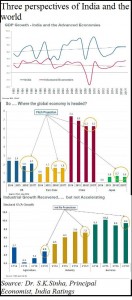http://www.freepressjournal.in/editorspick/where-from-here-decoding-indias-path-r-n-bhaskar/872029
India’s economic path: Quo vadis?
By any account, India appears to have done well. Unlike many advanced economies, which have registered a declining trend, India seems to be moving along an upward incline (see chart 1 alongside). India’s economic path is rapidly changing course.
But there are strong headwinds ahead. And India will have to steer its path very carefully, if it wants to ensure that it does not get hurt in the maelstrom that will follow. These were some of the views that were expressed last fortnight by Dr. S.K.Sinha, principal economist, with India Ratings & Research (a Fitch group company).
Some of the figures and projections are heartwarming for any Indian. Most advanced economies – including China – may not do as well as before (chart 2). But India will. Agricultural growth is expected to more than double, but still below the growth rate of FY2014. Industrial growth will not be as strong as during FY2015, but the growth rate is nothing to be sniffed at (chart 3).
Ditto with services. This sector will grow faster than the industry sector.
This is bound to reignite a debate that has been raging for the past decade. Industry wants the focus to be on manufacturing, because its votaries say that a vast economy like India needs to employ people who are not very skilled. That kind of growth say the captains of industry – and even some economists – can only come from manufacturing.
But there is another story that has unravelled lately. The growth of the virtual world has opened up new possibilities – including business process outsourcing (BPO) and other related services that are increasingly being offshored by other countries to India. The growth of the finance sector, the emergence of disruptive services like Paytm, Uber and Ola have turned the focus back on services. The army of people employed by the analytics sector is mind boggling. And the number of young vehicle drivers that have happily become partners with Uber and Ola – the two car sharing services – is a development that wasn’t anticipated earlier.
These services have the potential to reduce the role of manufacturing. They allow a single car to be used many times more than self-owned cars or even conventional taxis. And they create huge self employment opportunities as well.
Moreover, since governments are likely to be the largest outsourcers of work, e-governance will be a major driver. Just look at how the passport services sector has transformed itself. This was after the government outsourced much of the work to an IT and BPO company. Expect similar initiatives to ramp up new employment and business opportunities.
This has already happened with the way the Ministry of Corporate Affairs (MCA) works today. Much of the documentation work is being outsourced. In fact, the recent glitch in service performance levels that MCA experienced underscores the need to follow processes when switching over from one service provider to another. It is a skill that many bureaucrats will have to acquire.
Consequently, the untapped potential of the service industry is far larger than one imagines. Expect a surge in numbers here. It is quite possible that this sector will continue to grow faster than manufacturing for many more years to come.
As the government begins pushing the country towards better healthcare, the country will need more hospital beds, more diagnostic centres and even more transporters to ferry patients, medicare professionals, medicines and equipment. The nursing industry is likely to witness a growth that could make it several times larger than it is today. Moreover, with a growing geriatric population in much of the developed world, the possibilities of exploiting the manpower export potential in the nursing sector ought to become a thrust area for the government as well.
The same is true for tourism. But for that to grow, India will need to have better roads, better hotels, and most importantly, a law and order culture that does not allow tourists to be unfairly exploited, where remedial action is swift, without inconveniencing tourists, and where tourists are made to feel safe. If India can achieve all this, it could see the services sector racing even farther ahead than is being envisaged.
Most importantly, the government will have to empower its citizens in fighting corruption. A crucial step in this direction is to decriminalise much of bribe-giving. Unless this is done, there is little chance of bringing bribe-takers to book. Without this step, the law and order machinery will always find ways to extort money from both its citizens and from tourists.
If India can get its skill development and its policy framework working well, India’s economic growth might accelerate a lot more. Else, it will be another story of missed opportunities.






































COMMENTS